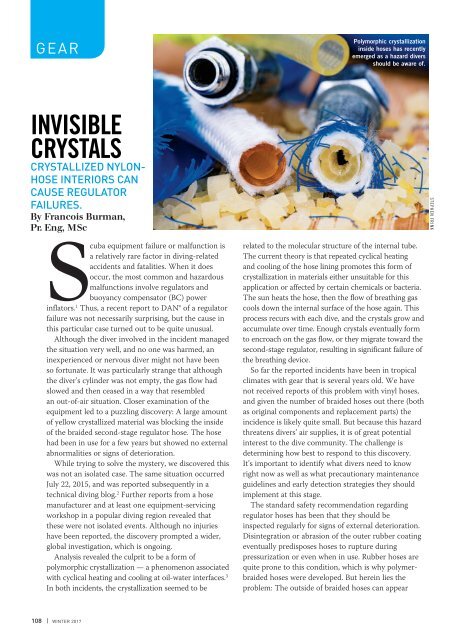AD 2017 Q1
Alert Diver is the dive industry’s leading publication. Featuring DAN’s core content of dive safety, research, education and medical information, each issue is a must-read reference, archived and shared by passionate scuba enthusiasts. In addition, Alert Diver showcases fascinating dive destinations and marine environmental topics through images from the world’s greatest underwater photographers and stories from the most experienced and eloquent dive journalists in the business.
Alert Diver is the dive industry’s leading publication. Featuring DAN’s core content of dive safety, research, education and medical information, each issue is a must-read reference, archived and shared by passionate scuba enthusiasts. In addition, Alert Diver showcases fascinating dive destinations and marine environmental topics through images from the world’s greatest underwater photographers and stories from the most experienced and eloquent dive journalists in the business.
You also want an ePaper? Increase the reach of your titles
YUMPU automatically turns print PDFs into web optimized ePapers that Google loves.
GEAR<br />
Polymorphic crystallization<br />
inside hoses has recently<br />
emerged as a hazard divers<br />
should be aware of.<br />
INVISIBLE<br />
CRYSTALS<br />
CRYSTALLIZED NYLON-<br />
HOSE INTERIORS CAN<br />
CAUSE REGULATOR<br />
FAILURES.<br />
By Francois Burman,<br />
Pr. Eng, MSc<br />
Scuba equipment failure or malfunction is<br />
a relatively rare factor in diving-related<br />
accidents and fatalities. When it does<br />
occur, the most common and hazardous<br />
malfunctions involve regulators and<br />
buoyancy compensator (BC) power<br />
inflators. 1 Thus, a recent report to DAN® of a regulator<br />
failure was not necessarily surprising, but the cause in<br />
this particular case turned out to be quite unusual.<br />
Although the diver involved in the incident managed<br />
the situation very well, and no one was harmed, an<br />
inexperienced or nervous diver might not have been<br />
so fortunate. It was particularly strange that although<br />
the diver’s cylinder was not empty, the gas flow had<br />
slowed and then ceased in a way that resembled<br />
an out-of-air situation. Closer examination of the<br />
equipment led to a puzzling discovery: A large amount<br />
of yellow crystallized material was blocking the inside<br />
of the braided second-stage regulator hose. The hose<br />
had been in use for a few years but showed no external<br />
abnormalities or signs of deterioration.<br />
While trying to solve the mystery, we discovered this<br />
was not an isolated case. The same situation occurred<br />
July 22, 2015, and was reported subsequently in a<br />
technical diving blog. 2 Further reports from a hose<br />
manufacturer and at least one equipment-servicing<br />
workshop in a popular diving region revealed that<br />
these were not isolated events. Although no injuries<br />
have been reported, the discovery prompted a wider,<br />
global investigation, which is ongoing.<br />
Analysis revealed the culprit to be a form of<br />
polymorphic crystallization — a phenomenon associated<br />
with cyclical heating and cooling at oil-water interfaces. 3<br />
In both incidents, the crystallization seemed to be<br />
related to the molecular structure of the internal tube.<br />
The current theory is that repeated cyclical heating<br />
and cooling of the hose lining promotes this form of<br />
crystallization in materials either unsuitable for this<br />
application or affected by certain chemicals or bacteria.<br />
The sun heats the hose, then the flow of breathing gas<br />
cools down the internal surface of the hose again. This<br />
process recurs with each dive, and the crystals grow and<br />
accumulate over time. Enough crystals eventually form<br />
to encroach on the gas flow, or they migrate toward the<br />
second-stage regulator, resulting in significant failure of<br />
the breathing device.<br />
So far the reported incidents have been in tropical<br />
climates with gear that is several years old. We have<br />
not received reports of this problem with vinyl hoses,<br />
and given the number of braided hoses out there (both<br />
as original components and replacement parts) the<br />
incidence is likely quite small. But because this hazard<br />
threatens divers’ air supplies, it is of great potential<br />
interest to the dive community. The challenge is<br />
determining how best to respond to this discovery.<br />
It’s important to identify what divers need to know<br />
right now as well as what precautionary maintenance<br />
guidelines and early detection strategies they should<br />
implement at this stage.<br />
The standard safety recommendation regarding<br />
regulator hoses has been that they should be<br />
inspected regularly for signs of external deterioration.<br />
Disintegration or abrasion of the outer rubber coating<br />
eventually predisposes hoses to rupture during<br />
pressurization or even when in use. Rubber hoses are<br />
quite prone to this condition, which is why polymerbraided<br />
hoses were developed. But herein lies the<br />
problem: The outside of braided hoses can appear<br />
STEPHEN FRINK<br />
108 | WINTER <strong>2017</strong>









